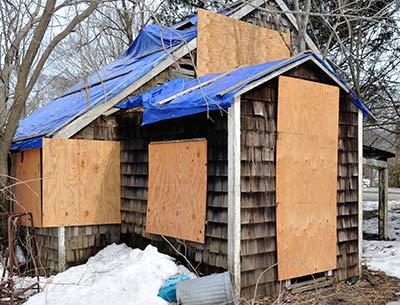Montaukett House Slated for Preservation

East Hampton Town this week got the go-ahead to designate as historic and preserve a house believed to be the sole surviving dwelling of the Montaukett Tribe, moved long ago from tribal land at Montauk’s Indian Field to a parcel on Springs-Fireplace Road in East Hampton.
The saltbox-style house was owned by George Lewis Fowler and his wife, Sarah Melissa Horton.
Now in serious disrepair, it was deeded to the town by Suffolk County, which had gained the land by tax default in 2002. The transfer was made with the proviso that the site be used for affordable housing, but that plan was put on hold when the property’s historical significance came to light. In a vote this week shepherded by County Legislator Jay Schneiderman, East Hampton’s representative, the Legislature approved a new plan for historic preservation of the site.
It is in what is known as Freetown, an area believed to have been first settled by former slaves of the Gardiner family of Gardiner’s Island and other wealthy local families.
In the late 19th century, Arthur Benson, a developer with designs on Montaukett land in Montauk, offered deeds to Freetown plots to entice Montauketts to vacate their tribal lands.
The deeds were “obtained by fraud and by undue influence,” the tribe later claimed, and in 1910, a tribal chief unsuccessfully sued the Benson heirs for the return of the ancestral lands.
“When they pushed us off Montauk they are said to have burned down some of the houses, but not all,” Jim Devine, a Fowler family descendant, told The Star in August.
A number were apparently moved from Montauk to Freetown, but the one now owned by the town is the only one that remains.
The George Fowler house, said Mr. Devine in a report provided to the County Legislature, “is an important historical site in the history of the Montauk Indians, the multiracial community of Freetown, and East Hampton generally.”
At one time, he said, it was surrounded by plantings including fruit trees, wild concord grapes, wildflowers and herbs, cultivated flowers, and ornamental grasses.
Mr. Fowler was employed for many years by the artist Thomas Moran, for whom he served as gardener and gondolier. He also tended the gardens at Home, Sweet Home.
The Moran house on Main Street in East Hampton has been declared a national historic landmark and is being restored.
In August, when the future of the Fowler house was in question, Robert Hefner, an East Hampton historic consultant, said that the house “completes the picture of the Moran house and Home, Sweet Home. This puts Main Street and Freetown together.”
James Fowler, one of Mr. Fowler’s ancestors, was born around 1700 in Montauk and married to Elizabeth Pharaoh, a descendant of the Sachem Wyandanch.
Other intermarriages between the two families followed, though only direct descendants of the Pharaoh line have been traditionally associated with the role of chief, or sachem, according to Mr. Devine.
A sister of George Lewis Fowler, the owner of the Springs-Fireplace Road house, married King David Pharaoh, becoming his queen.
In her 1950 book, “East Hampton History,” Jeannette Edwards Rattray said that the Pharaohs and the Fowlers were the last Indian families remaining in the community.
